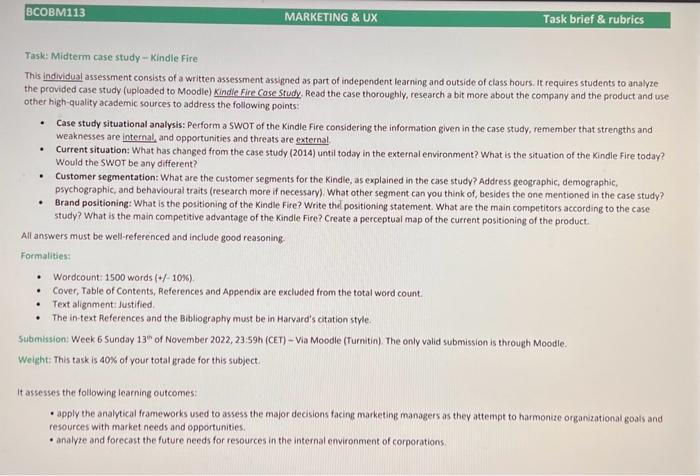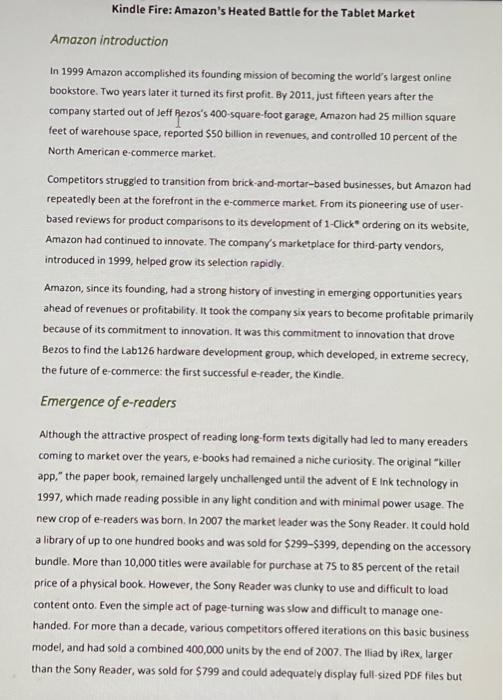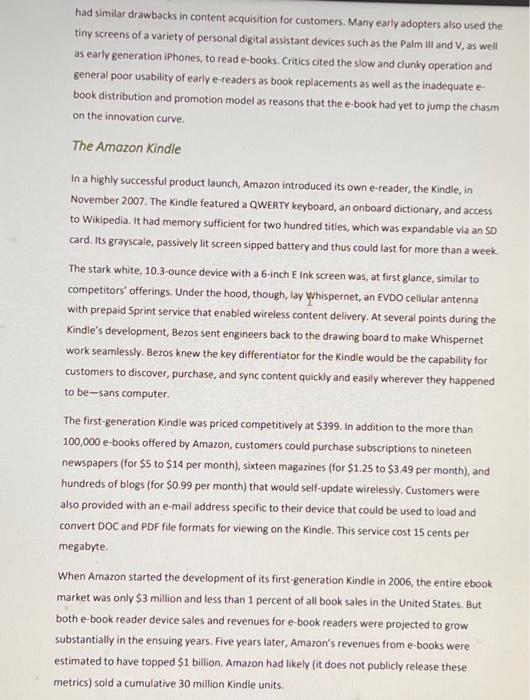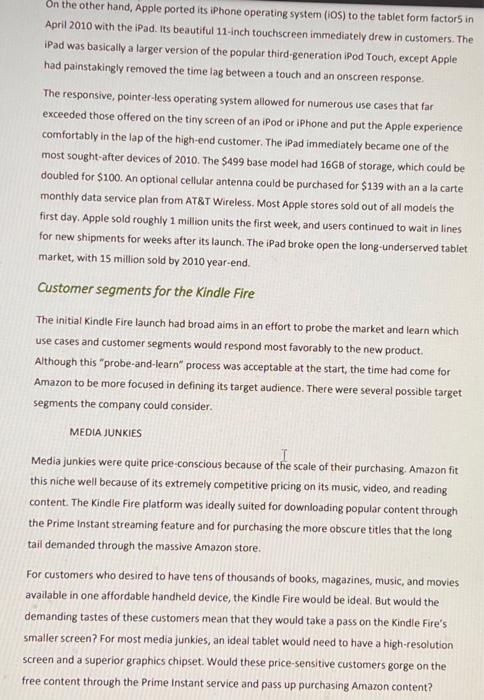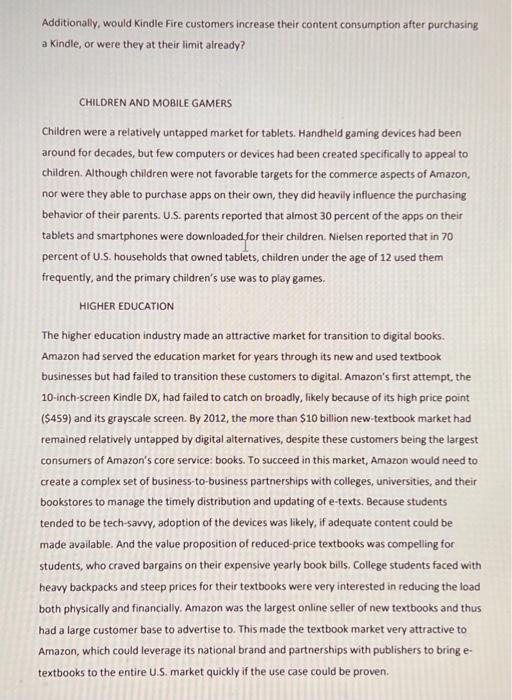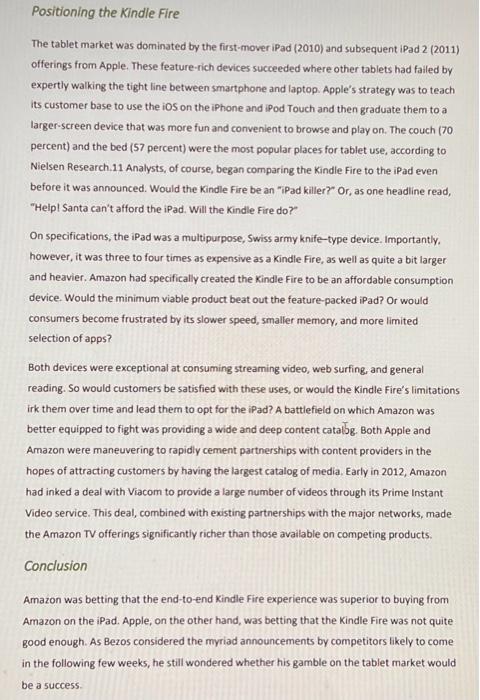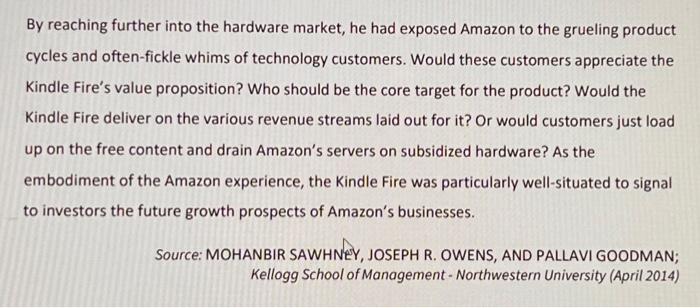This is the task brief / question
This is the case study needed for answering this question
Task: Midterm case study = Kindle Fire. This individual assessment consists of a written assessment assigned as part of independent learning and outside of class hours. It requires students to analyze the provided case study (uploaded to Moodle) Kindle Fice Case Study. Read the case thoroughly, research a bit more about the company and the product and use other high-quality academic sources to address the following points: - Case study situational analysis: Perform a SWOT of the Kindle Fire considering the information given in the case study, remember that strengths and weaknesses are internal, and opportunities and threats are external. - Current situation: What has changed from the case study (2014) until today in the external environment? What is the situation of the Kindle Fire today? Would the SWOT be any different? - Customer segmentation: What are the customer segments for the Kindie, as explained in the case study? Address geographic, demographic, psychographic, and behavioural traits (research more if necessary). What other segment can you think of, besides the one mentioned in the case study? - Brand positioning: What is the positioning of the Kindie Fire? Write thil positioning statement. What are the main competitors according to the case study? What is the main competitive advantage of the Kindle Fire? Create a perceptual map of the current positioning of the product. All answers must be well-referenced and include good reasoning. Formatities: - Wordcount: 1500 words (+/- 10\%). - Cover, Table of Contents, References and Appendix are excluded from the total word count. - Text alignmenti Jastified. - The in-text References and the Bibliography must be in Haryard's citation style. Submission: Week 6 Sunday 13s of November 2022, 23:59h (CET) - Via Moodle (Turnitin). The only valid submission is through Moodle. Weight: This task is 40% of your total grade for this subject. It assesses the following learning outcomes: - apply the analytical frameworks used to assess the major decisions facing marketing managers as they attempt to harmonize organizational goais and resources with market needs and opportunities. - analyze and forecast the future needs for resources in the internal environment of corporations. Kindle Fire: Amazon's Heated Battle for the Tablet Market Amazon introduction In 1999 Amazon accomplished its founding mission of becoming the world's largest online bookstore. Two years later it turned its first profit. By 2011, just fifteen years after the company started out of Jeff Rezos's 400-square-foot garage, Amazon had 25 million square feet of warehouse space, reported $50 billion in revenues, and controlled 10 percent of the North American e-commerce market. Competitors struggled to transition from brick-and-mortar-based businesses, but Amazon had repeatedly been at the forefront in the e-commerce market. From its pioneering use of userbased reviews for product comparisons to its development of 1 -Click ordering on its website, Amazon had continued to innovate. The company's marketplace for third-party vendors, introduced in 1999, helped grow its selection rapidly. Amazon, since its founding, had a strong history of investing in emerging opportunities years ahead of revenues or profitability. It took the company six years to become profitable primarily because of its commitment to innovation. It was this commitment to innovation that drove Bezos to find the Lab126 hardware development group, which developed, in extreme secrecy, the future of e-commerce: the first successful e-reader, the Kindle. Emergence of e-readers Although the attractive prospect of reading long-form texts digitally had led to many ereaders coming to market over the years, e-books had remained a niche curiosity. The original "killer app," the paper book, remained largely unchallenged until the advent of E ink technology in 1997, which made reading possible in any light condition and with minimal power usage. The new crop of e-readers was born. In 2007 the market leader was the Sony Reader. It could hold a library of up to one hundred books and was sold for $299$399, depending on the accessory bundle. More than 10,000 tities were available for purchase at 75 to 85 percent of the retail price of a physical book. However, the Sony Reader was clunky to use and difficult to load content onto. Even the simple act of page-turning was slow and difficult to manage onehanded. For more than a decade, various competitors offered iterations on this basic business model, and had sold a combined 400,000 units by the end of 2007 . The lliad by iRex, larger than the Sony Reader, was sold for $799 and could adequately display full-sized PDF files but had similar drawbacks in content acquisition for customers. Many early adopters also used the tiny screens of a variety of personal digital assistant devices such as the Palm III and V, as well as early generation iPhones, to read e-books. Critics cited the slow and clunky operation and general poor usability of early e-readers as book replacements as well as the inadequate ebook distribution and promotion model as reasons that the e-book had yet to jump the chasm on the innovation curve. The Amazon Kindle In a highly successful product launch, Amazon introduced its own e-reader, the Kindle, in November 2007. The Kindle featured a QWERTY keyboard, an onboard dictionary, and access to Wikipedia. It had memory sufficient for two hundred tities, which was expandable via an SO card. its grayscale, passively lit screen sipped battery and thus could last for more than a week. The stark white, 10.3-ounce device with a 6-inch E Ink screen was, at first glance, similar to competitors' offerings. Under the hood, though, lay Whispernet, an EvDO cellular antenna with prepaid Sprint service that enabled wireless content delivery. At several points during the Kindle's development, Bezos sent engineers back to the drawing board to make Whispernet work seamlessly. Bezos knew the key differentiator for the Kindie would be the capability for customers to discover, purchase, and sync content quickly and easily wherever they happened to be-sans computer. The first-generation Kindle was priced competitively at $399. In addition to the more than 100,000 e-books offered by Amazon, customers could purchase subscriptions to nineteen newspapers (for $5 to $14 per month), sixteen magazines (for $1.25 to $3.49 per month), and hundreds of blogs (for $0.99 per month) that would self-update wirelessly. Customers were also provided with an e-mail address specific to their device that could be used to load and convert DOC and PDF file formats for viewing on the Kindle. This service cost 15 cents per megabyte. When Amazon started the development of its first-generation Kindle in 2006, the entire ebook market was only $3 million and less than 1 percent of all book sales in the United States. But both e-book reader device sales and revenues for e-book readers were projected to grow substantially in the ensuing years. Five years later, Amazon's revenues from e-books were estimated to have topped $1 billion. Amazon had likely (it does not publicly release these metrics) sold a cumulative 30 million Kindle units. As the Kindle product line evolved, Amazon continued to enhance the user experience, mostly by improving navigational features such as page-turn speed, battery life, and screen resolution, and by reducing the device's weight and width. To expand the use cases for the Kindle product line, Amazon developed a larger version of the device. The $549 Kindle DX featured a 10 -inch screen, making it the ideal e-reader for displaying figures and tables from textbooks or business documents Amazon used its installed base of Kindle owners to push higher volumes of e-books, which had significantly lower distribution costs compared to physical books. The company's profit per title fell from $13 for a new-release hardcover to a mere $3, but the increase in volume compensated for this loss. Given that the gross margin on each Kindle device was barely 5 per cent and that the margin for each e-book was 20 to 30 per cent, the Kindle devices were arguably a tool for getting the Amazon ecosystem of content into the hands of the customer. With each e-book purchased from Amazon, customers were further committing themselves to the Amazon ecosystem, a completely unheard-of benefit in the traditional print space, where customers had complete independence in choosing a retailer. Bezos shrewdly knew that this lucrative customer base needed to be locked in before a competitor, such as B\&N, could do the same. Competition In October 2009 8\&N launched its Nook product line. The Nook, an E ink e-reader similar to the Kindle, was B\&N's attempt to capitalize on Amazon's success in e-books. The Nook featured a 6-inch E Ink screen, a seven-day battery life, Google's Android operating system, native PDF support, and wireless access to the B\&N e-bookstore through prepaid AT\&T cellular service. B\&N tried to undercut the Amazon Kindle 2 (then priced at $359 ) by pricing the Nook at $259. A price war ensued. Second generation Kindles fell from \$359 in early 2009 to $259 after the Nook's launch. As the two largest U.S. booksellers vied for the leading position, e-reader prices fell to less than $200 in 2010 and then to less than $100 in 2011 (for the simplest low-end devices from each product line). During this three-year period, sales of e-readers grew from less than 1 million units per year to more than 8 million in the United States. Both 8&N and Amazon were focused on getting their customers to build their digital libraries as quickly as possible. April 2010 with the iPad. Its beautiful 11-inch touchscreen immediately drew in customers. The iPad was basically a larger version of the popular third-generation iPod Touch, except Apple had painstakingly removed the time lag between a touch and an onscreen response. The responsive, pointer-less operating system allowed for numerous use cases that far exceeded those offered on the tiny screen of an iPod or iphone and put the Apple experience comfortably in the lap of the high-end customer. The iPad immediately became one of the most sought-after devices of 2010 . The $499 base model had 16GB of storage, which could be doubled for $100. An optional cellular antenna could be purchased for $139 with an a la carte monthly data service plan from AT\&T Wireless. Most Apple stores sold out of all models the first day. Apple sold roughly 1 million units the first week, and users continued to wait in lines for new shipments for weeks after its launch. The iPad broke open the long-underserved tablet market, with 15 million sold by 2010 year-end. Customer segments for the Kindle Fire The initial Kindle Fire launch had broad aims in an effort to probe the market and learn which use cases and customer segments would respond most favorably to the new product. Although this "probe-and-learn" process was acceptable at the start, the time had come for Amazon to be more focused in defining its target audience. There were several possible target segments the company could consider. MEDIAJUNKIES Media junkies were quite price-conscious because of the scale of their purchasing. Amazon fit this niche well because of its extremely competitive pricing on its music, video, and reading content. The Kindle Fire platform was ideally suited for downloading popular content through the Prime instant streaming feature and for purchasing the more obscure titles that the long tail demanded through the massive Amazon store. For customers who desired to have tens of thousands of books, magazines, music, and movies available in one affordable handheld device, the Kindle Fire would be ideal, But would the demanding tastes of these customers mean that they would take a pass on the Kindle Fire's smaller screen? For most media junkies, an ideal tablet would need to have a high-resolution screen and a superior graphics chipset. Would these price-sensitive customers gorge on the free content through the Prime instant service and pass up purchasing Amazon content? Additionally, would Kindle Fire customers increase their content consumption after purchasing a Kindle, or were they at their limit already? CHILDREN AND MOBILE GAMERS Children were a relatively untapped market for tablets. Handheld gaming devices had been around for decades, but few computers or devices had been created specifically to appeal to children. Although children were not favorable targets for the commerce aspects of Amazon, nor were they able to purchase apps on their own, they did heavily influence the purchasing behavior of their parents. U.S. parents reported that almost 30 percent of the apps on their tablets and smartphones were downloaded for their children. Nielsen reported that in 70 percent of U.S. households that owned tablets, children under the age of 12 used them frequently, and the primary children's use was to play games. HIGHER EDUCATION The higher education industry made an attractive market for transition to digital books. Amazon had served the education market for years through its new and used textbook businesses but had failed to transition these customers to digital. Amazon's first attempt, the 10-inch-screen Kindle DX, had failed to catch on broadly, likely because of its high price point ($459) and its grayscale screen. By 2012, the more than $10 billion new-textbook market had remained relatively untapped by digital alternatives, despite these customers being the largest consumers of Amazon's core service: books. To succeed in this market, Amazon would need to create a complex set of business-to-business partnerships with colleges, universities, and their bookstores to manage the timely distribution and updating of e-texts. Because students tended to be tech-savvy, adoption of the devices was likely, if adequate content could be made available. And the value proposition of reduced-price textbooks was compelling for students, who craved bargains on their expensive yearly book bills. College students faced with heavy backpacks and steep prices for their textbooks were very interested in reducing the load both physically and financially. Amazon was the largest online seller of new textbooks and thus had a large customer base to advertise to. This made the textbook market very attractive to Amazon, which could leverage its national brand and partnerships with publishers to bring etextbooks to the entire U.S. market quickly if the use case could be proven. Positioning the Kindle Fire The tablet market was dominated by the first-mover iPad (2010) and subsequent iPad 2 (2011) offerings from Apple. These feature-rich devices succeeded where other tablets had failed by expertly walking the tight line between smartphone and laptop. Apple's strategy was to teach its customer base to use the iOS on the iPhone and ipod Touch and then graduate them to a larger-screen device that was more fun and convenient to browse and play on. The couch (70) percent) and the bed ( 57 percent) were the most popular places for tablet use, according to Nielsen Research.11 Analysts, of course, began comparing the Kindle Fire to the iPad even before it was announced. Would the Kindle Fire be an "iPad killer?" Or, as one headine read, "Help! Santa can't afford the iPad. Will the Kindle Fire do?" On specifications, the iPad was a multipurpose, Swiss army knife-type device. Importantly. however, it was three to four times as expensive as a Kindle Fire, as well as quite a bit larger and heavier. Amazon had specifically created the Kindle Fire to be an affordable consumption device. Would the minimum viable product beat out the feature-packed iPad? Or would consumers become frustrated by its slower speed, smaller memory, and more limited selection of apps? Both devices were exceptional at consuming streaming video, web surfing, and general reading. So would customers be satisfied with these uses, or would the Kindle Fire's limitations irk them over time and lead them to opt for the iPad? A battlefield on which Amazon was better equipped to fight was providing a wide and deep content catalbg. Both Apple and Amazon were maneuvering to rapidly cement partnerships with content providers in the hopes of attracting customers by having the largest catalog of media, Early in 2012, Amazon had inked a deal with Viacom to provide a large number of videos through its Prime Instant: Video service. This deal, combined with existing partnerships with the major networks, made the Amazon TV offerings significantiy richer than those available on competing products. Conclusion Amazon was betting that the end-to-end Kindle Fire experience was superior to buying from Amazon on the iPad. Apple, on the other hand, was betting that the Kindle Fire was not quite good enough. As Bezos considered the myriad announcements by competitors likely to come in the following few weeks, he still wondered whether his gamble on the tablet market would be a success. By reaching further into the hardware market, he had exposed Amazon to the grueling product cycles and often-fickle whims of technology customers. Would these customers appreciate the Kindle Fire's value proposition? Who should be the core target for the product? Would the Kindle Fire deliver on the various revenue streams laid out for it? Or would customers just load up on the free content and drain Amazon's servers on subsidized hardware? As the embodiment of the Amazon experience, the Kindle Fire was particularly well-situated to signal to investors the future growth prospects of Amazon's businesses. SOURCe: MOHANBIR SAWHNE'Y, JOSEPH R. OWENS, AND PALLAVI GOODMAN; Kellogg School of Management - Northwestern University (April 2014) Task: Midterm case study = Kindle Fire. This individual assessment consists of a written assessment assigned as part of independent learning and outside of class hours. It requires students to analyze the provided case study (uploaded to Moodle) Kindle Fice Case Study. Read the case thoroughly, research a bit more about the company and the product and use other high-quality academic sources to address the following points: - Case study situational analysis: Perform a SWOT of the Kindle Fire considering the information given in the case study, remember that strengths and weaknesses are internal, and opportunities and threats are external. - Current situation: What has changed from the case study (2014) until today in the external environment? What is the situation of the Kindle Fire today? Would the SWOT be any different? - Customer segmentation: What are the customer segments for the Kindie, as explained in the case study? Address geographic, demographic, psychographic, and behavioural traits (research more if necessary). What other segment can you think of, besides the one mentioned in the case study? - Brand positioning: What is the positioning of the Kindie Fire? Write thil positioning statement. What are the main competitors according to the case study? What is the main competitive advantage of the Kindle Fire? Create a perceptual map of the current positioning of the product. All answers must be well-referenced and include good reasoning. Formatities: - Wordcount: 1500 words (+/- 10\%). - Cover, Table of Contents, References and Appendix are excluded from the total word count. - Text alignmenti Jastified. - The in-text References and the Bibliography must be in Haryard's citation style. Submission: Week 6 Sunday 13s of November 2022, 23:59h (CET) - Via Moodle (Turnitin). The only valid submission is through Moodle. Weight: This task is 40% of your total grade for this subject. It assesses the following learning outcomes: - apply the analytical frameworks used to assess the major decisions facing marketing managers as they attempt to harmonize organizational goais and resources with market needs and opportunities. - analyze and forecast the future needs for resources in the internal environment of corporations. Kindle Fire: Amazon's Heated Battle for the Tablet Market Amazon introduction In 1999 Amazon accomplished its founding mission of becoming the world's largest online bookstore. Two years later it turned its first profit. By 2011, just fifteen years after the company started out of Jeff Rezos's 400-square-foot garage, Amazon had 25 million square feet of warehouse space, reported $50 billion in revenues, and controlled 10 percent of the North American e-commerce market. Competitors struggled to transition from brick-and-mortar-based businesses, but Amazon had repeatedly been at the forefront in the e-commerce market. From its pioneering use of userbased reviews for product comparisons to its development of 1 -Click ordering on its website, Amazon had continued to innovate. The company's marketplace for third-party vendors, introduced in 1999, helped grow its selection rapidly. Amazon, since its founding, had a strong history of investing in emerging opportunities years ahead of revenues or profitability. It took the company six years to become profitable primarily because of its commitment to innovation. It was this commitment to innovation that drove Bezos to find the Lab126 hardware development group, which developed, in extreme secrecy, the future of e-commerce: the first successful e-reader, the Kindle. Emergence of e-readers Although the attractive prospect of reading long-form texts digitally had led to many ereaders coming to market over the years, e-books had remained a niche curiosity. The original "killer app," the paper book, remained largely unchallenged until the advent of E ink technology in 1997, which made reading possible in any light condition and with minimal power usage. The new crop of e-readers was born. In 2007 the market leader was the Sony Reader. It could hold a library of up to one hundred books and was sold for $299$399, depending on the accessory bundle. More than 10,000 tities were available for purchase at 75 to 85 percent of the retail price of a physical book. However, the Sony Reader was clunky to use and difficult to load content onto. Even the simple act of page-turning was slow and difficult to manage onehanded. For more than a decade, various competitors offered iterations on this basic business model, and had sold a combined 400,000 units by the end of 2007 . The lliad by iRex, larger than the Sony Reader, was sold for $799 and could adequately display full-sized PDF files but had similar drawbacks in content acquisition for customers. Many early adopters also used the tiny screens of a variety of personal digital assistant devices such as the Palm III and V, as well as early generation iPhones, to read e-books. Critics cited the slow and clunky operation and general poor usability of early e-readers as book replacements as well as the inadequate ebook distribution and promotion model as reasons that the e-book had yet to jump the chasm on the innovation curve. The Amazon Kindle In a highly successful product launch, Amazon introduced its own e-reader, the Kindle, in November 2007. The Kindle featured a QWERTY keyboard, an onboard dictionary, and access to Wikipedia. It had memory sufficient for two hundred tities, which was expandable via an SO card. its grayscale, passively lit screen sipped battery and thus could last for more than a week. The stark white, 10.3-ounce device with a 6-inch E Ink screen was, at first glance, similar to competitors' offerings. Under the hood, though, lay Whispernet, an EvDO cellular antenna with prepaid Sprint service that enabled wireless content delivery. At several points during the Kindle's development, Bezos sent engineers back to the drawing board to make Whispernet work seamlessly. Bezos knew the key differentiator for the Kindie would be the capability for customers to discover, purchase, and sync content quickly and easily wherever they happened to be-sans computer. The first-generation Kindle was priced competitively at $399. In addition to the more than 100,000 e-books offered by Amazon, customers could purchase subscriptions to nineteen newspapers (for $5 to $14 per month), sixteen magazines (for $1.25 to $3.49 per month), and hundreds of blogs (for $0.99 per month) that would self-update wirelessly. Customers were also provided with an e-mail address specific to their device that could be used to load and convert DOC and PDF file formats for viewing on the Kindle. This service cost 15 cents per megabyte. When Amazon started the development of its first-generation Kindle in 2006, the entire ebook market was only $3 million and less than 1 percent of all book sales in the United States. But both e-book reader device sales and revenues for e-book readers were projected to grow substantially in the ensuing years. Five years later, Amazon's revenues from e-books were estimated to have topped $1 billion. Amazon had likely (it does not publicly release these metrics) sold a cumulative 30 million Kindle units. As the Kindle product line evolved, Amazon continued to enhance the user experience, mostly by improving navigational features such as page-turn speed, battery life, and screen resolution, and by reducing the device's weight and width. To expand the use cases for the Kindle product line, Amazon developed a larger version of the device. The $549 Kindle DX featured a 10 -inch screen, making it the ideal e-reader for displaying figures and tables from textbooks or business documents Amazon used its installed base of Kindle owners to push higher volumes of e-books, which had significantly lower distribution costs compared to physical books. The company's profit per title fell from $13 for a new-release hardcover to a mere $3, but the increase in volume compensated for this loss. Given that the gross margin on each Kindle device was barely 5 per cent and that the margin for each e-book was 20 to 30 per cent, the Kindle devices were arguably a tool for getting the Amazon ecosystem of content into the hands of the customer. With each e-book purchased from Amazon, customers were further committing themselves to the Amazon ecosystem, a completely unheard-of benefit in the traditional print space, where customers had complete independence in choosing a retailer. Bezos shrewdly knew that this lucrative customer base needed to be locked in before a competitor, such as B\&N, could do the same. Competition In October 2009 8\&N launched its Nook product line. The Nook, an E ink e-reader similar to the Kindle, was B\&N's attempt to capitalize on Amazon's success in e-books. The Nook featured a 6-inch E Ink screen, a seven-day battery life, Google's Android operating system, native PDF support, and wireless access to the B\&N e-bookstore through prepaid AT\&T cellular service. B\&N tried to undercut the Amazon Kindle 2 (then priced at $359 ) by pricing the Nook at $259. A price war ensued. Second generation Kindles fell from \$359 in early 2009 to $259 after the Nook's launch. As the two largest U.S. booksellers vied for the leading position, e-reader prices fell to less than $200 in 2010 and then to less than $100 in 2011 (for the simplest low-end devices from each product line). During this three-year period, sales of e-readers grew from less than 1 million units per year to more than 8 million in the United States. Both 8&N and Amazon were focused on getting their customers to build their digital libraries as quickly as possible. April 2010 with the iPad. Its beautiful 11-inch touchscreen immediately drew in customers. The iPad was basically a larger version of the popular third-generation iPod Touch, except Apple had painstakingly removed the time lag between a touch and an onscreen response. The responsive, pointer-less operating system allowed for numerous use cases that far exceeded those offered on the tiny screen of an iPod or iphone and put the Apple experience comfortably in the lap of the high-end customer. The iPad immediately became one of the most sought-after devices of 2010 . The $499 base model had 16GB of storage, which could be doubled for $100. An optional cellular antenna could be purchased for $139 with an a la carte monthly data service plan from AT\&T Wireless. Most Apple stores sold out of all models the first day. Apple sold roughly 1 million units the first week, and users continued to wait in lines for new shipments for weeks after its launch. The iPad broke open the long-underserved tablet market, with 15 million sold by 2010 year-end. Customer segments for the Kindle Fire The initial Kindle Fire launch had broad aims in an effort to probe the market and learn which use cases and customer segments would respond most favorably to the new product. Although this "probe-and-learn" process was acceptable at the start, the time had come for Amazon to be more focused in defining its target audience. There were several possible target segments the company could consider. MEDIAJUNKIES Media junkies were quite price-conscious because of the scale of their purchasing. Amazon fit this niche well because of its extremely competitive pricing on its music, video, and reading content. The Kindle Fire platform was ideally suited for downloading popular content through the Prime instant streaming feature and for purchasing the more obscure titles that the long tail demanded through the massive Amazon store. For customers who desired to have tens of thousands of books, magazines, music, and movies available in one affordable handheld device, the Kindle Fire would be ideal, But would the demanding tastes of these customers mean that they would take a pass on the Kindle Fire's smaller screen? For most media junkies, an ideal tablet would need to have a high-resolution screen and a superior graphics chipset. Would these price-sensitive customers gorge on the free content through the Prime instant service and pass up purchasing Amazon content? Additionally, would Kindle Fire customers increase their content consumption after purchasing a Kindle, or were they at their limit already? CHILDREN AND MOBILE GAMERS Children were a relatively untapped market for tablets. Handheld gaming devices had been around for decades, but few computers or devices had been created specifically to appeal to children. Although children were not favorable targets for the commerce aspects of Amazon, nor were they able to purchase apps on their own, they did heavily influence the purchasing behavior of their parents. U.S. parents reported that almost 30 percent of the apps on their tablets and smartphones were downloaded for their children. Nielsen reported that in 70 percent of U.S. households that owned tablets, children under the age of 12 used them frequently, and the primary children's use was to play games. HIGHER EDUCATION The higher education industry made an attractive market for transition to digital books. Amazon had served the education market for years through its new and used textbook businesses but had failed to transition these customers to digital. Amazon's first attempt, the 10-inch-screen Kindle DX, had failed to catch on broadly, likely because of its high price point ($459) and its grayscale screen. By 2012, the more than $10 billion new-textbook market had remained relatively untapped by digital alternatives, despite these customers being the largest consumers of Amazon's core service: books. To succeed in this market, Amazon would need to create a complex set of business-to-business partnerships with colleges, universities, and their bookstores to manage the timely distribution and updating of e-texts. Because students tended to be tech-savvy, adoption of the devices was likely, if adequate content could be made available. And the value proposition of reduced-price textbooks was compelling for students, who craved bargains on their expensive yearly book bills. College students faced with heavy backpacks and steep prices for their textbooks were very interested in reducing the load both physically and financially. Amazon was the largest online seller of new textbooks and thus had a large customer base to advertise to. This made the textbook market very attractive to Amazon, which could leverage its national brand and partnerships with publishers to bring etextbooks to the entire U.S. market quickly if the use case could be proven. Positioning the Kindle Fire The tablet market was dominated by the first-mover iPad (2010) and subsequent iPad 2 (2011) offerings from Apple. These feature-rich devices succeeded where other tablets had failed by expertly walking the tight line between smartphone and laptop. Apple's strategy was to teach its customer base to use the iOS on the iPhone and ipod Touch and then graduate them to a larger-screen device that was more fun and convenient to browse and play on. The couch (70) percent) and the bed ( 57 percent) were the most popular places for tablet use, according to Nielsen Research.11 Analysts, of course, began comparing the Kindle Fire to the iPad even before it was announced. Would the Kindle Fire be an "iPad killer?" Or, as one headine read, "Help! Santa can't afford the iPad. Will the Kindle Fire do?" On specifications, the iPad was a multipurpose, Swiss army knife-type device. Importantly. however, it was three to four times as expensive as a Kindle Fire, as well as quite a bit larger and heavier. Amazon had specifically created the Kindle Fire to be an affordable consumption device. Would the minimum viable product beat out the feature-packed iPad? Or would consumers become frustrated by its slower speed, smaller memory, and more limited selection of apps? Both devices were exceptional at consuming streaming video, web surfing, and general reading. So would customers be satisfied with these uses, or would the Kindle Fire's limitations irk them over time and lead them to opt for the iPad? A battlefield on which Amazon was better equipped to fight was providing a wide and deep content catalbg. Both Apple and Amazon were maneuvering to rapidly cement partnerships with content providers in the hopes of attracting customers by having the largest catalog of media, Early in 2012, Amazon had inked a deal with Viacom to provide a large number of videos through its Prime Instant: Video service. This deal, combined with existing partnerships with the major networks, made the Amazon TV offerings significantiy richer than those available on competing products. Conclusion Amazon was betting that the end-to-end Kindle Fire experience was superior to buying from Amazon on the iPad. Apple, on the other hand, was betting that the Kindle Fire was not quite good enough. As Bezos considered the myriad announcements by competitors likely to come in the following few weeks, he still wondered whether his gamble on the tablet market would be a success. By reaching further into the hardware market, he had exposed Amazon to the grueling product cycles and often-fickle whims of technology customers. Would these customers appreciate the Kindle Fire's value proposition? Who should be the core target for the product? Would the Kindle Fire deliver on the various revenue streams laid out for it? Or would customers just load up on the free content and drain Amazon's servers on subsidized hardware? As the embodiment of the Amazon experience, the Kindle Fire was particularly well-situated to signal to investors the future growth prospects of Amazon's businesses. SOURCe: MOHANBIR SAWHNE'Y, JOSEPH R. OWENS, AND PALLAVI GOODMAN; Kellogg School of Management - Northwestern University (April 2014)
